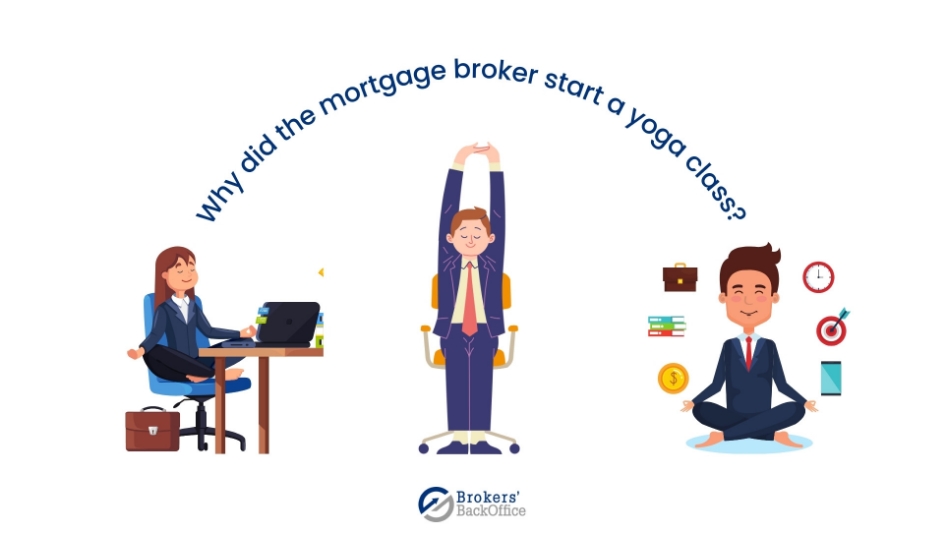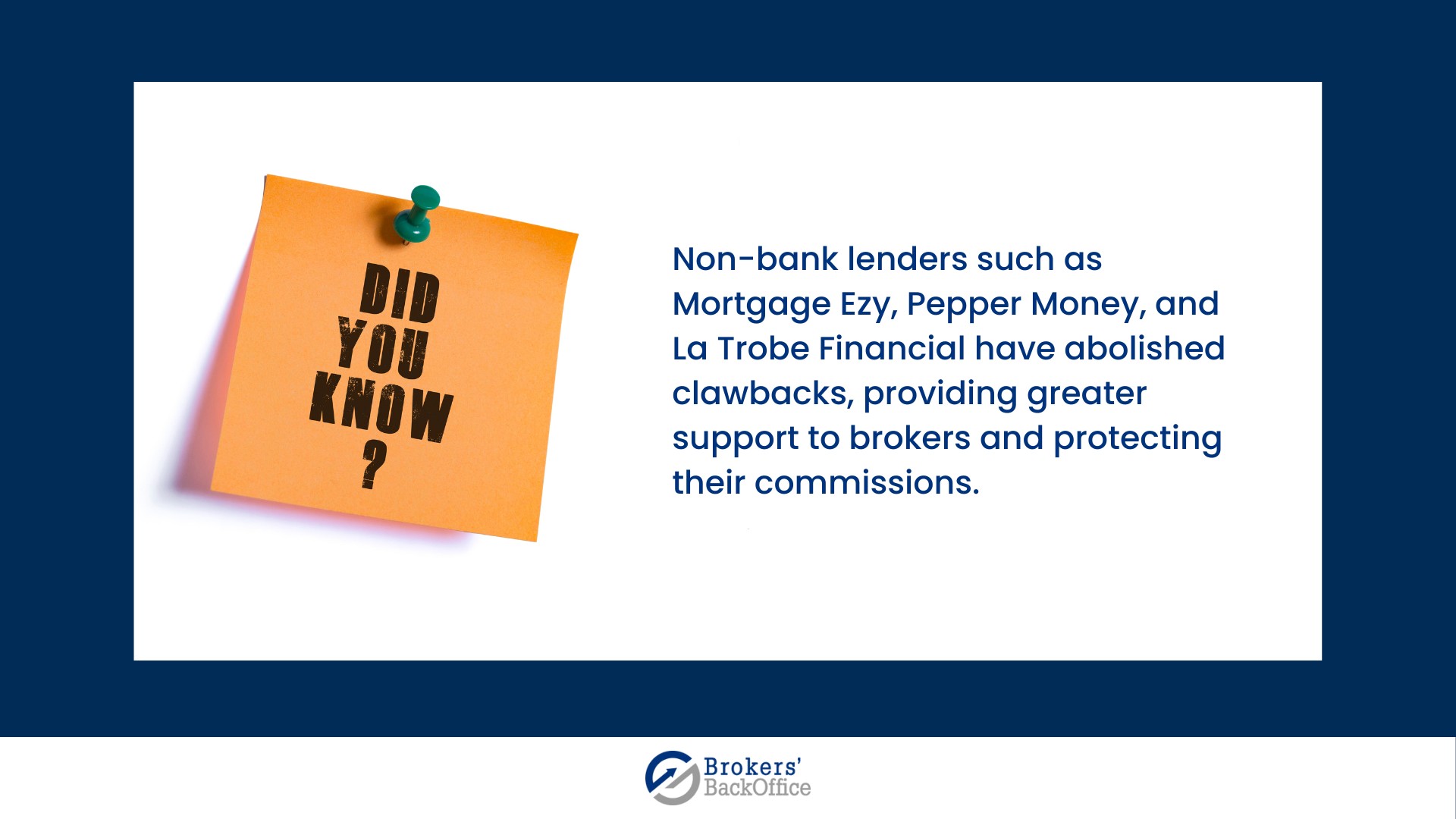
Safeguard your hard-earned commissions: Winning the battle against mortgage broker commission clawback
As a mortgage broker, you are well aware that your commissions reflect your expertise, dedication, and hard work. That's why it's vital to anticipate and overcome the challenges of clawback, ensuring your financial success remains intact.
At Brokers' BackOffice, a leading outsourced loan processing firm in Australia, we understand the unique needs of mortgage brokers. That's why we have created an exclusive guide, tailored to provide valuable insights and expert strategies to safeguard and maximize your hard-earned upfront and trail commissions.
Clawback significantly impacts mortgage brokers' earnings. It refers to reimbursing previously received commissions when clients pay off their loans early or refinance within a specified period. This practice can harm your financial well-being, eroding the rewards of your efforts and undermining your business growth.
Join us on this insightful journey as we delve into the nuances of mortgage broker clawback prevention and provide actionable insights that will elevate your approach to protecting your commissions.
Key takeaways
- Proactively communicate with clients and keep them informed about market trends and refinancing opportunities to mitigate the risk of clawback.
- Monitor borrowers' loan performance for early signs of potential clawback triggers.
- Implement measures, such as leveraging advanced technology, to protect your commissions.
- Seek out reliable outsourcing partners who are committed to helping you avoid clawback fees.
What is clawback?
Clawback refers to the fee banks or lenders impose on mortgage brokers when home loans are prepaid or refinanced within two years of settlement. The specific fee amount varies among lenders, but typically it equals the full upfront commission initially paid to the broker if the home loan is prepaid within the first year. The clawback fee may be reduced to 50 percent of the upfront commission in the second year.
Let’s look at how clawback could impact a mortgage broker financially.
Consider a mortgage broker named Laura. Laura has successfully closed a loan for a client with a principal amount of $500,000. For this loan, Laura receives an upfront commission of 0.60% and a trail commission of 0.15% annually.
The upfront commission Laura receives at the start of the loan is:
$500,000 * 0.60% = $3,000
Each year, she will receive a trail commission of:
$500,000 * 0.15% = $750
In the first year, the total commission Laura earns from this loan is
$3,000 (upfront) + $750 (trail) = $3,750
Now, let's say Laura's client decides to refinance the loan with another lender after one year. In this case, a commission clawback occurs. In Australia, it is common for the clawback to be 100% of the upfront commission if the loan is refinanced within the first year.
So, Laura has to return the entire upfront commission of $3,000 to the original lender. Plus, she will not receive any further trail commissions from this loan, as the loan is no longer under the original lender.
This leads to a significant loss for Laura. Instead of earning $3,750 in the first year and then $750 per year thereafter, she ends up with a net income of $750 in the first year ($3,750 earned - $3,000 clawed back), and no further income from this loan.
This example illustrates the financial impact that commission clawbacks can have on mortgage brokers. In reality, the situation can be even more complex, as brokers often handle multiple loans, each with its own terms and potential for clawback. This underlines the importance of implementing strategies to mitigate the risk of clawbacks.
What is the regulation regarding clawback?
In response to the industry's concerns, the Finance Brokers Association of Australia (FBAA) and the Mortgage & Finance Association of Australia (MFAA) have strongly advocated completely removing unfair clawbacks. However, the Federal Government has implemented new regulations that limit the maximum clawback period to two years.
Under the new regulations, clawback arrangements are prohibited if they extend beyond two years from the start of the credit contract. For consumer arrangements, this period commences on the first day when the credit is initially drawn down, while for refinancing credit, it begins on the day following the availability of the refinanced credit.
This government stance addresses mortgage brokers' concerns by setting a clear time frame for clawback limitations, offering more certainty and protection for brokers in their business operations.

Can the mortgage broker pass the clawback fees to the customer?
Amid increasing competition in the lending market and rising interest rates, mortgage brokers have noticed a rise in cashback offers from lenders, enticing borrowers with new mortgage products. Unfortunately, this intensified competition has led to a surge in refinancing, aggravating the issue of mortgage broker clawback.
As borrowers change lenders in pursuit of better deals or cashback incentives, mortgage brokers find that the upfront commissions the broker receives from the original lender are being clawed back.
According to the Finance Brokers Association of Australia (FBAA), the cost of clawbacks for brokers has experienced a substantial 47.4% surge between 2018 and 2021. Understandably, this situation has frustrated brokers, with some considering passing these clawback fees to their clients.
However, recent regulations prohibit brokers from transferring the burden of mortgage broker clawback fees to customers. The new rules explicitly state that "the consumer must not be obligated to pay an amount as a result of the repayment obligation requiring repayment."
This development holds substantial importance as it provides consumer protection by preventing the imposition of additional charges when switching loans within a clawback period.
What are the reasons behind mortgage broker commission clawback?
Clawback in the mortgage industry occurs for various reasons, primarily related to early home loan repayments or refinancing. Let's go through these reasons in more detail:
-
Early loan repayments:
When borrowers repay their loans earlier than expected, lenders may seek to reclaim a portion of the upfront commission paid to brokers. Early loan settles can result from various factors, such as selling the property, receiving a windfall, or simply wanting to reduce debt. Lenders charge clawbacks to mitigate the financial impact caused by the loss of interest income over the original loan term.
-
Refinancing:
Refinancing involves replacing an existing loan with a new loan to take advantage of better interest rates and loan deal or to access additional funds. When borrowers choose to refinance within a specific period, banks or lenders may clawback a portion of the commission the broker receives. Refinancing disrupts the original loan agreement, impacting the lender's profitability and anticipated interest earnings.
-
Lender profitability and risk management:
Clawback provisions also serve as a risk management tool for lenders. By reclaiming commissions, lenders can offset potential losses from borrowers paying off loans early or refinancing. The clawback provision allows lenders to maintain profitability and manage the risks of changing market conditions, interest rates, and borrower behaviour.
-
Commission recoupment:
Clawback provisions ensure that brokers only receive upfront and trail commission for loans that remain active for a reasonable period. This discourages brokers from engaging in practices prioritising short-term gains over extended borrower satisfaction and home loan performance. Clawback provisions align broker interests with the lender's goal of promoting sustainable and successful loan outcomes.
A lighthearted take on the broker and client relationship with an important message.

Because he wanted to teach his clients the art of balance! Just like in yoga, where maintaining balance is the key to mastering any pose, the mortgage world also requires a fine balance.
The balance between selecting the right loan and sticking to it as well as striking a balance between paying off your mortgage and not rushing it so fast that your broker faces a commission clawback.
In this class, we don't say 'Namaste' - we say 'I must stay... with my loan for at least two years'. It is not your typical yoga class, but hey, at least there's no risk of clawbacks, and the only stretching you will do is maybe stretching your understanding of the mortgage industry!
Remember, just like you wouldn't leave a yoga class halfway (imagine being stuck in a warrior pose forever), you shouldn't rush to refinance your loan. Stick around, give it time. Breathe in, breathe out, hold that loan pose... you have got this!
And if all else fails, your broker will be there, yoga mat in hand, ready to help you find your balance in the mortgage market.

What are the ways to avoid clawback and increase client retention?
In the competitive Australian mortgage market, customer retention is paramount. It is not just about securing a single transaction but about establishing a relationship that lasts for years, even decades.
As a mortgage broker, you are tasked not only with helping clients find the best mortgage options but also with maintaining their loyalty. Below are several strategies to boost customer retention and ensure your customers keep coming back.
-
Listen actively and communicate clearly
Active listening is the cornerstone of good customer service. When clients feel heard and understood, they are more likely to trust and value your service. Be sure to fully comprehend your clients' needs and concerns before proposing solutions. Additionally, always communicate clearly, avoiding industry jargon that might confuse your clients.
-
Respond quickly
Speedy responses show clients that you value their time and are committed to assisting them. This applies to all forms of communication, from phone calls to emails to social media messages. Even if you can't provide a full answer immediately, a quick acknowledgment can show your client that you are on the case.
-
Be available
In today's fast-paced world, clients expect services to be available outside of traditional working hours. By offering flexible availability, you can meet your clients at times that are convenient for them, further improving their experience.
-
Stay informed
The mortgage market is continuously changing. Stay updated on industry trends, regulatory changes, and new mortgage products. Your clients will appreciate your expertise and your ability to provide them with the best advice. Moreover, educating your clients about these changes can empower them to make informed decisions, fostering trust and loyalty.
-
Leverage technology
Use technology to streamline your processes and improve your service. There are numerous software solutions available for customer relationship management (CRM), which can help you track client interactions and identify opportunities for follow-ups. Tools like automated email marketing, and digital document signing can streamline the mortgage application process.
-
Offer ongoing support
Don't let your relationship with your clients end once the mortgage is approved. Regular follow-ups show clients that you care about their ongoing satisfaction. This could involve checking in to see how they are settling in, offering additional financial advice, or reminding them of upcoming mortgage milestones. This helps to build long-term relationships and encourages clients to return when they need further services.
-
Develop a referral program
People are more likely to trust a service that's been recommended by someone they know. Developing a referral program can incentivize your current clients to recommend you to others. Not only can this bring in new clients, but it can also strengthen your relationships with your existing ones.
-
Request and respond to feedback
Regularly ask for feedback from your clients. This can help you identify areas of your service that may need improvement. More importantly, act on the feedback you receive. Show your clients that you value their opinions and are willing to make changes to improve their experience.
-
Personalise your services
Every client is unique, with different needs and preferences. Personalising your services can show your clients that you understand and care about their individual situations. This can include everything from flexible meeting times to customised mortgage options.
-
Be transparent
Transparency is key in building trust with your clients. Be upfront about your fees and the pros and cons of different mortgage options. If your clients feel that you are being honest and open with them, they are more likely to remain loyal to your services

Effective strategies for mortgage brokers to surge ahead and outsmart the clawback trap?
Clawback can significantly impact a broker's income. Here are some strategies that can help mortgage brokers avoid or mitigate the effects of commission clawback.
-
Educate your clients
One of the most effective ways to prevent commission clawback is by educating your clients. Explain the loan process, including the costs associated with refinancing or early repayment. Once they understand that frequent changes could end up costing them more in the long run, they may be less inclined to refinance or pay off their loan early.
-
Choose the right loan for each client
Make sure you fully understand your client's needs and financial situation before suggesting a loan. The better the loan suits the client, the less likely they are to refinance or pay off early. This also underscores the importance of having a comprehensive range of loan products at your disposal to cater to different customer needs.
-
Monitor loan performance
Stay vigilant and monitor borrower's loan performance to identify early signs of potential clawback triggers. Advanced technology solutions, such as Sherlok, a repricing and refinancing tool that uses advanced AI algorithms to accurately predict clients at a higher risk of leaving. By prioritising these clients for repricing, brokers can proactively retain them and ensure their satisfaction.
-
Diversify your income
While it is important to focus on strategies that directly prevent commission clawbacks, it is also wise to have a backup plan. Diversifying your income can help protect you from the financial impact of clawbacks. This could include offering additional services, such as insurance or financial planning, that can generate additional revenue.
-
Negotiate clawback terms with lenders
When partnering with lenders, try to negotiate more favourable clawback terms. Some lenders have longer clawback periods or higher clawback rates, so it is worth shopping around to find a lender whose terms are more suitable for your business model.
-
Create a clawback reserve fund
One way to cushion the financial impact of clawback is to create a reserve fund. This involves setting aside a portion of each commission received into a separate account. If a clawback occurs, you can use the funds in this account to repay the commission, minimising the impact on your cash flow.
By adopting this range of proactive measures and leveraging advanced technology, mortgage brokers can effectively mitigate clawback risks, protect their upfront and trail commission payments, and provide superior service to their customers in the dynamic Australian mortgage market.
Current buzz
The recent changes in the banking sector have seen a move towards more broker-friendly policies. The Commonwealth Bank of Australia (CBA), for instance, made significant changes to its clawback strategy for broker commissions, specifically for loans that are refinanced within a two-year period.
Beginning on October 1, 2023, the first year's clawback provisions have been left unchanged, with brokers continuing to retain 50% of the upfront commission after the first year. The remaining 50% will now be distributed over the second year in a consistently declining monthly manner, fully paid by the 24th month.
CBA, recognising the potential negative effects on brokers' income and borrower outcomes associated with cashbacks, had already taken proactive steps. They led the way by cancelling their cashback offer from June 1. This action set a precedent that was soon followed by several other lending institutions such as NAB, Westpac, and Bankwest.
This evolution, however, is not just restricted to traditional banking institutions. There's been a significant development in the non-bank lending space as well. As early as April 1, Mortgage Ezy took the bold step of completely eradicating clawbacks from all its products. Pepper Money is another non-bank lender that has already discarded clawbacks for its commercial mortgage offerings, and is in the process of reassessing their approach to residential mortgages. Additionally, La Trobe Financial has consistently maintained a no-clawbacks policy for its lending products.
All of these policy changes reflect a positive trend within the industry, prioritising fairness and offering increased support to mortgage brokers and their clients. It is clear that these financial institutions, both banks and non-bank lenders alike, are aiming to foster an environment where brokers and clients can focus on the long-term benefits of their home loans.
Final note
Avoiding clawback is crucial for mortgage brokers to protect their hard-earned commissions. By implementing key strategies, mortgage brokers can minimise the risk of clawback fees and ensure long-term success.
Furthermore, incorporating proactive measures helps mortgage brokers retain customers, expect customer satisfaction, and safeguard their upfront and trail commission.
As a trusted outsourcing firm specialising in loan processing services and back-office activities, Brokers' BackOffice is committed to supporting mortgage brokers to avoid clawback fee.
We invite brokers to explore our services, including our pay per application and dedicated team member service model, to streamline their operations, enhance efficiency, and maximise their business outcomes. Our experienced professionals can help you in keeping in touch with your clients and building strong relations.
Visit our website or contact us today to see how we can assist you in avoiding clawback fee and achieving more tremendous success in your mortgage broking endeavours.
Table of contents
What is clawback? Let’s look at how clawback could impact a mortgage broker financially. What is the regulation regarding clawback? Can the mortgage broker pass the clawback fees to the customer? What are the reasons behind mortgage broker commission clawback? A lighthearted take on the broker and client relationship with an important message. What are the ways to avoid clawback and increase client retention? Effective strategies for mortgage brokers to surge ahead and outsmart the clawback trap? Current Buzz Final word